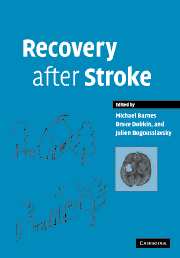Book contents
- Frontmatter
- Contents
- List of authors
- Preface
- 1 Stroke: background, epidemiology, etiology and avoiding recurrence
- 2 Principles of recovery after stroke
- 3 Regenerative ability in the central nervous system
- 4 Cerebral reorganization after sensorimotor stroke
- 5 Some personal lessons from imaging brain in recovery from stroke
- 6 Measurement in stroke: activity and quality of life
- 7 The impact of rehabilitation on stroke outcomes: what is the evidence?
- 8 Is early neurorehabilitation useful?
- 9 Community rehabilitation after stroke: is there no place like home?
- 10 Physical therapy
- 11 Abnormal movements after stroke
- 12 Spasticity and pain after stroke
- 13 Balance disorders and vertigo after stroke: assessment and rehabilitation
- 14 Management of dysphagia after stroke
- 15 Continence and stroke
- 16 Sex and relationships following stroke
- 17 Rehabilitation of visual disorders after stroke
- 18 Aphasia and dysarthria after stroke
- 19 Cognitive recovery after stroke
- 20 Stroke-related dementia
- 21 Depression and fatigue after stroke
- 22 Sleep disorders after stroke
- 23 Technology for recovery after stroke
- 24 Vocational rehabilitation
- 25 A patient's perspective
- Index
9 - Community rehabilitation after stroke: is there no place like home?
Published online by Cambridge University Press: 05 August 2016
- Frontmatter
- Contents
- List of authors
- Preface
- 1 Stroke: background, epidemiology, etiology and avoiding recurrence
- 2 Principles of recovery after stroke
- 3 Regenerative ability in the central nervous system
- 4 Cerebral reorganization after sensorimotor stroke
- 5 Some personal lessons from imaging brain in recovery from stroke
- 6 Measurement in stroke: activity and quality of life
- 7 The impact of rehabilitation on stroke outcomes: what is the evidence?
- 8 Is early neurorehabilitation useful?
- 9 Community rehabilitation after stroke: is there no place like home?
- 10 Physical therapy
- 11 Abnormal movements after stroke
- 12 Spasticity and pain after stroke
- 13 Balance disorders and vertigo after stroke: assessment and rehabilitation
- 14 Management of dysphagia after stroke
- 15 Continence and stroke
- 16 Sex and relationships following stroke
- 17 Rehabilitation of visual disorders after stroke
- 18 Aphasia and dysarthria after stroke
- 19 Cognitive recovery after stroke
- 20 Stroke-related dementia
- 21 Depression and fatigue after stroke
- 22 Sleep disorders after stroke
- 23 Technology for recovery after stroke
- 24 Vocational rehabilitation
- 25 A patient's perspective
- Index
Summary
Introduction
Many hospitals in the western world now have a dedicated stroke unit. There is no doubt that such units provide an important role in the overall management of stroke and there is now hard evidence of their efficacy (see Ch. 8). However, while people who survive stroke may have a slightly shorter life expectancy than the general population, they will often still have many years of life back at home, back at work, and back in the community. The stroke unit may have maximized their recovery in the few months after the stroke but it is likely that there is still further recovery potential in the months and years after discharge from hospital. It would also be important to avoid unnecessary complications, such as muscle contractures secondary to spasticity or problems with incontinence. In worldwide terms, those admitted to a stroke unit are in the lucky minority and most people will not be admitted to hospital or, if they are admitted to acute medical ward, will probably be discharged quite quickly. These people will be in need of active rehabilitation in a community setting. Consequently, virtually all disabled survivors of stroke will need some form of community-based rehabilitation. Such support is sadly lacking across the world.
There are some indications that health systems around the world are beginning to recognize the longer-term health and rehabilitation needs of disabled people who are living at home. In many countries, particularly in Europe, government resources are beginning to be directed away from acute, and expensive, hospitals towards a health system that is delivered within the local community. There is increasing emphasis on the family physician and the primary care team. There are now a number of initiatives that help to support disabled people within their own homes and indeed prevent unnecessary admission or readmission to hospital. There are also a number of other schemes that facilitate early discharge from hospital. There are slowly increasing numbers of health professionals who have a remit to work in the community. The nursing profession has long had thistradition, but there are a number of schemes that are placing expert rehabilitation nurses in the community. More slowly, there are signs that the medical profession and the therapy professions are also beginning to develop community roles.
- Type
- Chapter
- Information
- Recovery after Stroke , pp. 209 - 225Publisher: Cambridge University PressPrint publication year: 2005



